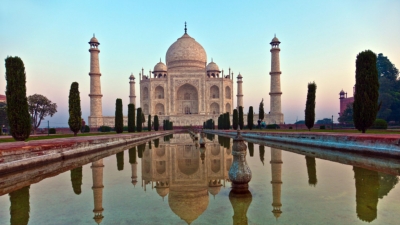
The Taj Mahal was built by the Mogul emperor Shah Jahan (1614-66) as a tomb for his favourite wife, Mumtaz Mahal. It is situated at Agra in northern India and is one of the most beautiful buildings in the world. When the Moguls arrived in India early in the 16th Century, they brought Persian civilization with them. The tomb is a perfect example of the Persian style of architecture.
The name of the tomb means “Crown of the Palace”, one of the titles given to the Empress Mumtaz. It is built of white marble, inlaid with precious stones, and is eight sided, 130 feet across at its widest points and nearly 200 feet high to the top of the huge dome. It is flanked on each side by two slender minarets and stands on a vast marble terrace overlooking the River Jumma and surrounded by Persian gardens.
Inside, under the dome, are the marble cenotaphs or monuments of Shah Jahan and his empress, on which the sun flickers through marble screens as delicate and intricate as lace. The walls are covered in floral designs and inscriptions from the Koran, picked out in onyx, jasper, cornelian and other semi-precious stones. The tombs which hold the royal bodies are in a vaulted chamber below and, in contrast to the chamber itself, are quite plain.
According to a legend the marvellous building appeared to Mumtaz in a dream and the Shah searched the whole of India for an architect. The plans were said to have been drawn up only after the architect had been given a drug which enabled him to see a vision of the monument in all its splendour and glory.
Picture Credit : Google




